Hey readers!!!
As per the 2024 Forbes Advisor Ecommerce Statistics, it is projected that global ecommerce sales will attain a remarkable $6.8 trillion.
Furthermore, by the year 2028, online retail transactions are anticipated to represent 24% of all retail purchases.
Businesses are always looking for ways to enhance the customer experience. To do this, retailers are jumping on new technologies and finding creative ways to sell their products.
One of the hottest trends in ecommerce right now is headless technology. So, what is headless commerce? It’s a term that’s starting to catch on in the industry, so let’s dive into the headless commerce definition and see what it’s all about!
Key Takeaways On Headless Commerce Definition
- Headless commerce definition explains how separating the frontend and backend lets you create flexible and unique ecommerce solutions.
- Understanding the headless commerce meaning – helps deliver seamless shopping experiences across multiple platforms and devices.
- Headless ecommerce definition highlights how it combines APIs and integrations to create scalable and innovative digital storefronts.
- The headless commerce definition enables brands to enhance performance and customer satisfaction with agile, flexible systems.
- Adopting the headless commerce technology positions your business for growth with future-proof technology and omnichannel adaptability.
According to the Yotta Ecommerce Survey, 62% of companies agree that Headless E commerce platforms can significantly increase engagement and conversions.
In light of the exponential growth of online shopping, businesses are actively seeking methods to enhance the online experience for their customers. The Headless Platform has notably emerged as a favored solution.
If you’re curious about what is headless commerce explained and how it can transform your online business, I encourage you to continue reading this article.
Furthermore, it delves deeply into the concept of headless technologies, including the headless commerce advantages it can provide. Indeed, from increased speed and flexibility to enhanced customer engagement and loyalty, it offers numerous benefits for retailers in today’s digital landscape. Therefore, let us embark on a journey to explore the realm of headless commerce together.
Headless Commerce vs. Traditional Ecommerce: What’s the Difference?
Understanding the distinction between headless and traditional ecommerce can help businesses choose the right approach for growth and innovation.
| Traditional Ecommerce | Headless Commerce |
| Tightly Coupled Architecture Front-end and back-end are integrated, so changes in one affect the other, leading to lengthy development cycles and higher error risks. | Decoupled Architecture Front-end and back-end operate independently, offering unmatched flexibility for updates without disruptions. |
| Limited Adaptability Adjusting to market changes or customer demands is cumbersome, slowing innovation and feature deployment. | High Adaptability Easily integrates new features, trends, or customer preferences, ensuring continuous innovation. |
| Moderate Scalability Scaling is possible but needs help with complex traffic or business needs. | Unlimited Scalability Ideal for high-growth businesses, handling spikes in traffic or complex operations efficiently. |
| Challenging Omnichannel Integration Creating seamless multichannel experiences requires extensive customization. | Streamlined Omnichannel Experience Consistent branding across web, mobile, and voice platforms is simpler with decoupling. |
| Slower Time-to-Market Rigid structures need to roll out new updates, making businesses disadvantaged. | Quick Time-to-Market Faster development cycles enable businesses to launch updates quickly, staying ahead of competitors. |
What is Headless Commerce?

The ecommerce platform separates the front-end presentation layer from back-end operations.
This approach enables businesses to create engaging digital experiences for their customers while leveraging the robust ecommerce capabilities of their chosen platform.
Headless commerce website development represents an advanced strategy for scaling in the online retail sector.
Ecommerce can provide several benefits for businesses, including
- Increased flexibility and agility in terms of design and development.
- The ability to seamlessly integrate Ecommerce functionality into existing websites and applications.
- Improved customer experiences through highly personalized digital experiences.
- Reduced costs associated with maintaining multiple front-end systems.
- Decoupling allows businesses to adopt a more agile approach to their commerce architecture, making it easier to adapt to changes in consumer behavior and technological advancements.
Why it Matters for Your Ecommerce Business
Headless commerce is valuable for businesses seeking flexibility in delivering personalized online experiences. What is headless commerce? It’s a model that separates the front-end from the back-end, enabling innovative, customizable ecommerce solutions that adapt to customer needs
This approach gives designers and developers the freedom to focus on creating the best user experience without being limited by the platform’s technical restrictions. It also allows businesses to adapt quickly to changing market trends and customer needs by easily adding features or making updates without disrupting the core ecommerce system.
Moreover, headless technology enables businesses to embrace new technologies like voice assistants and augmented reality, making online shopping even more interactive. By using APIs to connect the front-end and back-end, these innovations can seamlessly integrate into ecommerce platforms.
Key Components of Headless Commerce
The key components are the front-end, back-end, and API. The front-end is the user interface that customers interact with, while the back-end is the server and database that store and manage product data, inventory, and customer information. The API is the bridge that connects the front-end and back-end and allows them to communicate with each other.
What Are the Benefits of Headless Ecommerce Platform?

1. Unmatched Flexibility for Customization
One of the primary headless commerce advantages is the extensive freedom it offers for customization.
Utilizing a headless commerce platform, businesses can craft distinctive, branded front-end experiences that are fully aligned with their identity.
This level of flexibility empowers retailers to develop personalized shopping journeys that not only capture customers attention but also foster lasting loyalty.
Consequently, businesses can distinguish themselves and prosper in a competitive marketplace.
2. Enhanced Website Performance
By decoupling the front end from the back end, headless technology significantly enhances website performance.
With quicker page load times and more responsive interfaces, customers benefit from a smoother and more enjoyable shopping experience.
This improvement not only reduces bounce rates but also increases conversion rates, ultimately leading to higher sales.
3. Scalable Architecture for Business Growth
Headless commerce is designed for growth.
Its adaptable architecture enables businesses to seamlessly add new features or scale their operations without disrupting the user experience.
This capability facilitates quick adaptation to changing customer needs and emerging market trends, ensuring that your business remains ahead of the competition.
4. Omnichannel Consistency
Another notable benefit is the ability to provide a consistent and seamless shopping experience across all devices and platforms.
Whether customers are shopping on desktops, smartphones, or smart devices, headless technologies guarantees a smooth, unified experience.
This omnichannel approach allows customers to engage with your brand on their terms, thereby enhancing their overall shopping experience.
5. Effortless Integration with Third-Party Tools
Integrating essential tools such as payment gateways, CRM systems, and marketing platforms is straightforward with a headless e commerce platforms.
This seamless integration streamlines operations, simplifies processes, and improves overall efficiency, making it easier to manage your ecommerce business.
Headless Ecommerce Architecture? Exploring the Concept of Decoupling

BusinessDasher reveals 82.91% of companies adopting headless systems report better efficiency, with enterprises allocating $2.6M on average to this transformative technology.
Headless architecture separates the front-end and back-end of a web application. This allows for greater flexibility and scalability. The back-end (CMS) stores and manages content, while the front-end retrieves and displays it using various technologies.
This decoupling enables developers to use different technologies for each layer and reuse content across multiple platforms.
Interesting Fact*
When Spotify switched to a headless architecture, they were able to rapidly release new features and experiments across multiple platforms (web, mobile, desktop) simultaneously.
This agility allowed them to stay ahead of the competition and quickly adapt to changing user preferences, resulting in a 20% increase in user engagement.
How to Achieve This?
A headless commerce platform enables quick development and deployment of new features and experiences.
This agility allows businesses to quickly adapt to market trends and customer preferences, leading to an average 30% increase in conversion rates and a 25% decrease in time-to-market for new features.
How Headless Commerce Works?
Let’s know about how headless ecommerce works. It is a modern approach to building ecommerce websites that separates the front-end UI from the back-end ecommerce platform.
This implies that the ecommerce platform’s back-end is separate from the website’s front-end, which provides greater versatility and expandability in creating and providing online shopping experiences.
The website builder or CMS generates the front end of the UI. In contrast, the back end of the e-commerce platform handles various functions, such as managing product catalogs, inventory, payments, order processing, and fulfillment.
The two systems communicate with each other via APIs, which enable the front-end UI to access data and functionality from the back-end platform.
Experience the Future
of Online Selling with Headless Commerce!
Integrating 4 Core Technologies in Headless Ecommerce
- Content Management System (CMS)
- Progressive Web App (PWA)
- Customer Relationship Management (CRM)
- Digital experience platform (DXP)
Headless commerce can offer a seamless and personalized shopping experience for customers by intergrating these 4 core technologies:
1. Content Management System (CMS)
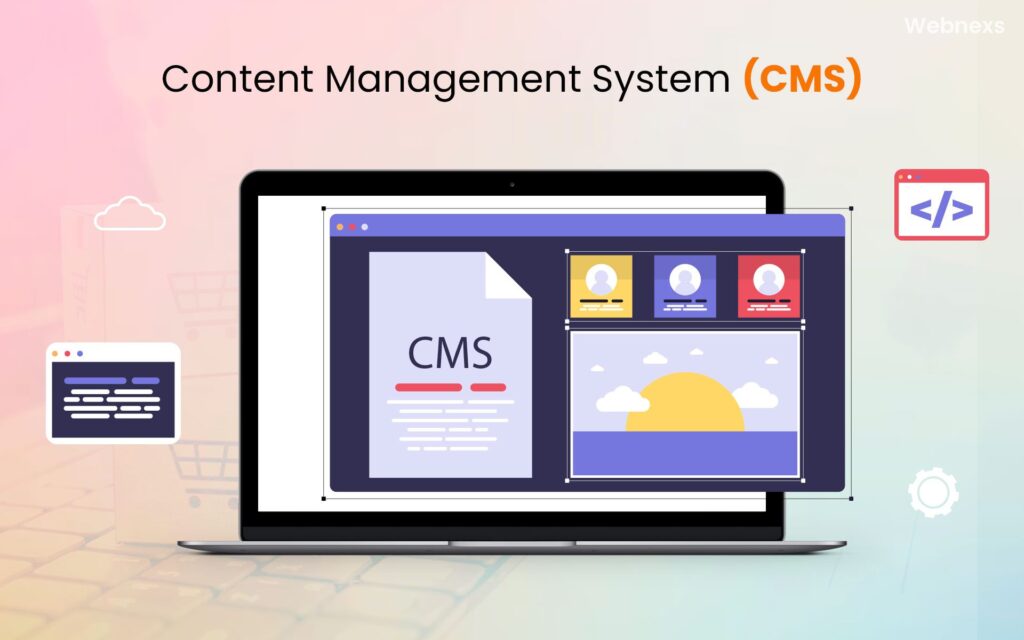
A Content Management System (CMS) is a software application designed to enable users to create, manage, and publish digital content, including text, images, and videos, across websites and various digital channels.
CMS Headless Commerce Meaning
Headless commerce CMS platform empowers businesses to manage their ecommerce content and assets through a headless architecture.
Headless CMS for ecommerce allows businesses to create a customized front-end user interface that meets their specific design and user experience requirements by separating the presentation layer of the front-end from the back end of the content management system.
This approach, used by many headless CMS ecommerce solutions, enables greater flexibility and scalability for building unique and seamless online shopping experiences.
Additionally, they can utilize a dynamic and versatile back-end system to achieve this goal.
The back-end system manages the ecommerce content and assets, such as product information, images, videos, and marketing campaigns.
Businesses can construct the front-end UI using various content management platforms, including Contentful, Strapi, or customized solutions while utilizing modern web technologies such as React, Vue.js, or Angular.
These technologies allow the front-end UI to communicate with the back-end system via APIs.
How Does Headless Commerce CMS Work?
Experro’s recent analysis shows that the headless CMS market is projected to expand from about $1.25 billion in 2023 to over $3.8 billion by 2028, reflecting a compound annual growth rate (CAGR) of 25%.
When headless architecture ecommerce is combined with a CMS, it forms a powerful ecommerce solution. By separating the platform from the presentation layer, businesses can leverage popular CMS platforms like WordPress or DXPs such as Bloomreach, providing a tailored customer experience.
This approach is particularly effective for omnichannel strategies, as a single CMS can manage content across multiple channels. APIs then connect the front-end and back-end, offering flexibility and enhanced user interfaces, which leads to better engagement and higher conversions.
Interesting Fact*
When Nike adopted headless commerce, they reduced their time-to-market for new ecommerce features by 40%.
By decoupling their front-end and back-end, Nike tailored experiences for different markets while maintaining centralized content management.
This flexibility resulted in a 30% boost in online sales and improved customer engagement across all channels.
How to Achieve This?
To implement a headless commerce CMS, choose a strong CMS like Webnexs Headless CMS, design a flexible front-end using frameworks with tech like React, connect with APIs, optimize speed using CDN hosting, and continuously test and improve.
This approach can lead to up to a 35% increase in customer retention and faster time-to-market.
Visit Here: Headless Commerce CMS – What, When & How To Choose Explained
Advantages of Headless Commerce CMS
There are several benefits of using headless commerce CMS for ecommerce businesses, including.
- Flexibility
Provides businesses with enhanced flexibility to create a personalized storefront that reflects their brand’s distinct style and personality. E commerce headless CMS enables businesses to differentiate themselves in a highly competitive ecommerce market and deliver a superior user experience to their customers.
- Scalability
It can manage heavy traffic and deliver speedy page loads, resulting in a seamless shopping experience for customers.
- Customization
Allows businesses to customize their Ecommerce platform’s functionality, such as product management, order processing, and payment processing, to meet their specific needs.
- Integration
It can integrate with a variety of back-end systems, such as ERP or CRM software, providing businesses with greater control over their Ecommerce operations.
- Cost-Effective
It’s more cost-effective than traditional Ecommerce platforms in the long run, as businesses only pay for the features they need and can avoid the costs of maintaining a monolithic ecommerce platform.
Headless Commerce CMS is ideal for omni-channel retail, content-driven, and international ecommerce. As the world becomes increasingly digital, businesses that want to stay competitive must adopt this new technology to stay ahead of the curve.
Here are some additional Headless commerce CMS components that are essential
- Product Management
Have a powerful system that allows you to create, manage, and update products, categories, and attributes. Headless commerce CMS includes the ability to manage inventory, pricing, and promotions.
- Order Management
Have a robust system that allows you to manage and track orders, shipments, and returns. This includes the ability to integrate with payment gateways, shipping carriers, and other third-party systems.
- Frontend System
Allows you to customize the front-end presentation of your products and categories using modern front-end frameworks, such as React, Vue, or Angular. Headless commerce CMS allows you to create a unique and engaging shopping experience for your customers.
- Multi-Channel Support
Support multiple channels and devices, such as desktop, mobile, and tablet. Headless commerce CMS includes the ability to deliver content and products across multiple touchpoints and integrate with other marketing and sales channels.
- Analytics
Have built-in analytics capabilities that allow you to track user behavior, measure campaign performance, and gain insights into your Ecommerce operations. Headless commerce CMS includes the ability to track key metrics, such as conversion rates, average order value, and customer lifetime value.
- Personalization
Features are becoming increasingly important for Ecommerce success. It should especially have the ability to customize content and product recommendations based on user behavior and preferences.
Similarly, by focusing on these key components, businesses can ensure that their Headless Ecommerce CMS is equipped with the necessary tools and capabilities to manage product data, provide a seamless shopping experience, and drive sales and revenue growth.
To know more: Headless Ecommerce CMS Development: The Key to Streamlining Your Online Business
2. Progressive Web App (PWA)
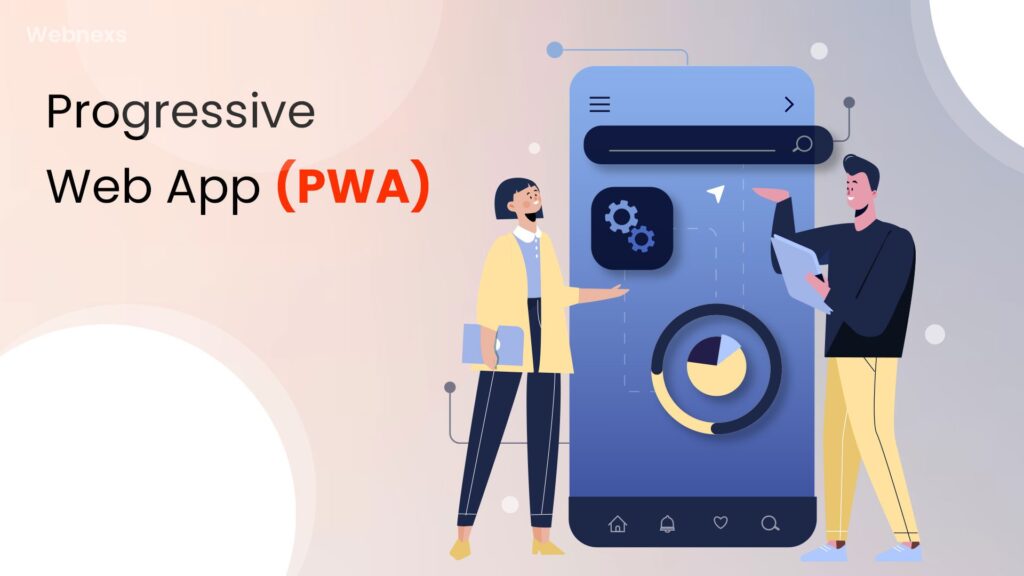
A web application that uses modern web technologies to provide a native app-like experience to users. With headless commerce meaning, businesses can use a PWA to construct a responsive, speedy, and interactive front-end user interface that connects to the back-end ecommerce platform via APIs.
PWA Headless ecommerce Meaning
A web application that combines headless architecture with PWA technology. The headless technologies order management approach optimizes the front-end UI for mobile devices with fast loading times, while the back-end system handles the commerce functionality.
This enables businesses to create a customized front-end that meets their specific design and UX requirements while leveraging a robust and scalable back-end system
How Does Headless Commerce PWA Work?
According to Magenest, global eCommerce sales are projected to reach $7.5 trillion by 2025, driven by headless commerce and PWAs. By 2028, online retail purchases are expected to account for 24% of total retail sales
Developers build headless commerce PWAs using modern web technologies, including React, Vue.js, Angular, and other JavaScript frameworks, providing a modular and reusable codebase that can be easily customized and extended.
They construct the front-end UI using these frameworks and communicate with the back-end system using APIs.
The back-end system is responsible for handling commerce functionality, such as product catalog management, order processing, payment gateway integration, and shipping.
Businesses can build a headless commerce PWA using any commerce platform, including Webnexs, Wcart, Shopify, WooCommerce, or custom-built solutions.
Many headless commerce companies offer the tools and expertise needed to create fast, scalable, and customizable shopping experiences across all devices.
The front-end communicates with the back-end system using APIs, which provide a flexible and scalable integration. This means that businesses can easily add new features or services to their commerce platform without affecting the front-end UI.
Interesting Fact*
When Alibaba implemented a PWA with a headless commerce structure, they achieved a 76% increase in mobile conversion rates.
The decoupled architecture enabled faster load times, offline functionality, and seamless user experiences, significantly enhancing engagement and driving sales globally.
How to Achieve This?
Develop a headless commerce PWA using frameworks like React or Node.js for a responsive front-end, APIs for smooth back-end integration, and CDNs for performance optimization.
This strategy improves user experience, reduces time-to-market, and boosts conversions by 30%.
Advantages of Headless Commerce PWA
There are several benefits of using how headless commerce works with PWA for ecommerce businesses, including.
- Fast loading times
Utilize fast loading times to improve the user experience and reduce bounce rates. By providing a fast and responsive front-end UI that is optimized for mobile devices, businesses can benefit from using headless commerce PWAs.
- Improved SEO
Allows businesses to optimize their e-commerce platform for search engines. As PWAs are web applications, search engines can index them, enhancing the website’s visibility and rankings.
- Enhanced user experience
Provides a seamless and app-like user experience that can improve engagement and conversion rates. Businesses can customize the front-end UI to meet their specific design and UX requirements.
- Scalability
Provides a scalable and flexible architecture that can handle a large volume of traffic and transactions. Depending on the business needs, it is easy to scale up or down the back-end system.
- Cost-effective
Headless commerce PWA can be more cost-effective than traditional e-commerce platforms. Businesses can build a customized front-end UI without having to invest in a new back-end system because the front-end and back-end systems are decoupled.
Visit Here: Headless Commerce PWA, SPA, MPA – Everything You Need to Know
3. Customer Service Management (CRM)
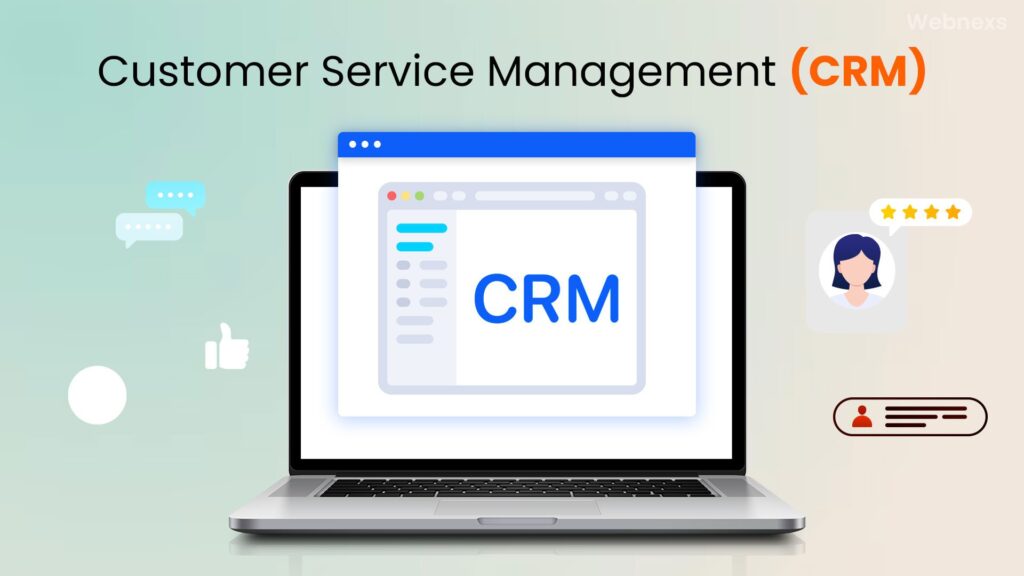
A system that manages a company’s interactions with current and potential customers. Headless technology allows the use of a CRM to store customer data and manage marketing campaigns, while the ecommerce platform handles the transactional aspects of the shopping experience.
CRM Headless Ecommerce Meaning
A new approach to ecommerce that involves separating the front-end and back-end components of an online store. In this approach, the front-end or UI is decoupled from the back-end or server-side logic.
The front end can be built and customized independently of the back end, allowing for more flexibility and scalability in the design and functionality of an online store.
How Does Headless Commerce CRM Work?
Headless commerce CRM separates the customer-facing interface from the behind-the-scenes systems that manage business operations. The customer-facing interface controls the design, layout, and overall user experience, while the back-end systems handle tasks like inventory management, order processing, and payment handling.
The key benefit of this separation is that the two components can function independently, allowing businesses to have greater flexibility in customization.
For instance, a company can design a unique, user-friendly interface that caters specifically to its customers needs, while maintaining the same strong operational processes behind the scenes.
This approach uses modern technologies such as React, or Node.js to create dynamic and interactive user interfaces, while APIs connect and integrate with other systems and services to ensure smooth operation.
Interesting Fact*
When Sephora adopted a headless commerce CRM, they saw a 35% faster page load time and a 50% increase in mobile conversions.
This helped them offer highly personalized shopping experiences, leading to improved customer satisfaction and increased revenue.
How to Achieve This?
To achieve similar results, businesses can use front-end frameworks like React or Node.js, connect to an API-based back end like Webnexs , and optimize performance with Content Delivery Networks (CDNs).
This approach improves speed, scalability, and user engagement, boosting conversions by up to 30%.
Top 5 Advantages of Headless Commerce CRM
There are several benefits to using how headless commerce solution works with the CRM approach for ecommerce
- Customization
Businesses can customize the UI of their online store to meet the specific needs of their customers. This can lead to a better user experience and increased customer satisfaction.
- Scalability
CRM platforms are highly scalable, meaning they can handle large amounts of traffic and transactions without sacrificing performance.
- Flexibility
These are highly flexible, meaning businesses can add new features and functionality to their online store without disrupting the existing back-end logic.
- Integration
They are designed to seamlessly integrate with other applications and services, making it easier to manage inventory, process orders, and handle payments.
- Future-proofing
In particular it can adapt to new technologies and trends as they emerge. This ensures that businesses can stay ahead of the curve and remain competitive in the ever-changing ecommerce landscape.
Headless Ultimate Solution for Unlimited Growth!
4. Digital Experience Platforms (DXP)
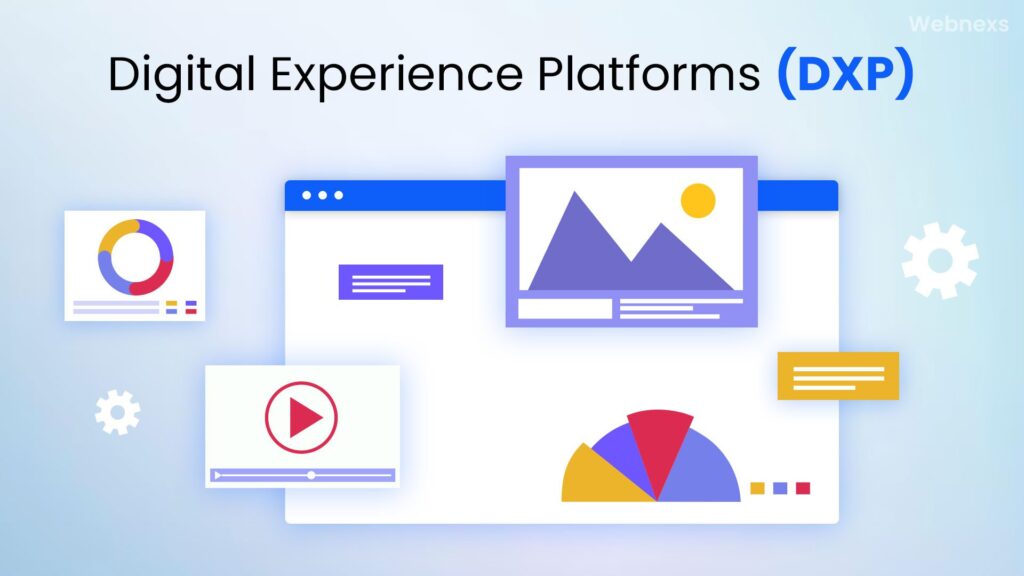
Digital Experience Platforms (DXP) are software solutions that help businesses manage and deliver digital experiences across multiple channels, such as websites, mobile apps, and social media platforms. A DXP typically includes content management, personalization, marketing automation, and analytics capabilities.
DXP Headless Ecommerce Meaning
Headless Commerce DXP is a type of DXP that separates the front-end presentation layer from the back-end ecommerce functionality. In general, this approach allows businesses to have more control and flexibility over their digital experiences.
How Does Headless Commerce DXP Work?
A Digital Experience Platform (DXP) is a software solution designed to help businesses quickly adapt to the digital world and deliver a more personalized experience for their customers. By combining a DXP with a headless Content Management System (CMS), businesses can create a strong and flexible foundation for managing digital content and interactions across multiple platforms.
The main advantage of this combination lies in the flexibility offered by API-driven content. APIs enable different systems to communicate and share information seamlessly, allowing businesses to integrate their DXP with other services or tools, such as marketing platforms, customer relationship management (CRM) systems, or ecommerce solutions.
This setup benefits both developers and marketers. Developers can focus on building and maintaining the back-end infrastructure, while marketers can manage and create content for various channels without being concerned about the technical side.
Interesting Fact*
After adopting headless commerce DXPs, brands like Adidas experienced a 40% increase in online sales.
The ability to separate content management from other business operations allowed them to deliver personalized experiences and faster service across all channels.
This flexibility helped them stay ahead of market trends, boosting customer engagement and satisfaction.
How to Achieve This?
To implement a headless commerce DXP effectively, businesses should leverage modern technologies like React or Node.js to create highly responsive and engaging customer experiences.
By integrating APIs, businesses can ensure seamless communication with other business systems, allowing for easy scalability and expansion.
Optimizing performance with CDNs will enhance site speed, increase user engagement, and drive higher conversions, ultimately leading to long-term growth.
4 Advantages of Headless Commerce DXP
There are several benefits to using how headless commerce works with the DXP approach for ecommerce
- Flexibility
Enables businesses to deliver consistent and personalized experiences across multiple channels and devices.
- Scalability
Allows businesses to add new channels and touchpoints without disrupting the back-end ecommerce functionality.
- Customization
Provides greater flexibility for front-end developers to customize the customer experience without affecting the back-end e-commerce functionality.
- Future-Proofing
Enables businesses to stay up-to-date with emerging technologies and channels by providing a flexible and adaptable architecture.
Visit Here: What are headless commerce microservices?
Features of Headless Commerce For Customers
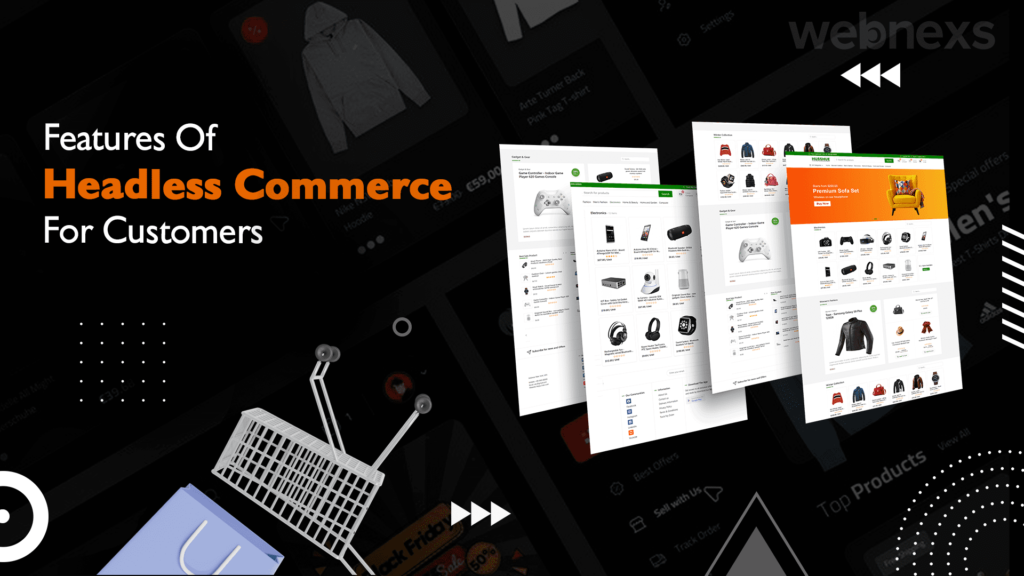
Webnexs is a multi-vendor ecommerce platform that comes into existence with the headless ecommerce meaning. It allows endless customization and provides its own experience for users and admins. It works by APIs.
1. Greater scalability and flexibility
Enables you to quickly scale up or down without being specified by the capabilities of a particular platform or system.
2. Seamless user experience
Allows retailers to create a seamless shopping experience for customers across various touchpoints. Front-end is decoupled, and businesses can customize the UI for each device and channel, creating a more consistent personalized shopping experience.
3. Faster page loading times
Front-end is lightweight and optimized for performance, and pages load faster, which improves the overall user experience and reduces bounce rates.
4. Better mobile experience
Retailers can create mobile-first experiences that are optimized for mobile devices, providing a better experience for customers who shop on their smartphones.
5. Integration with third-party services
Allows retailers to integrate with third-party services, like payment gateways and shipping providers, to payment and delivery options for customers.
6. Improved security and privacy
As there is no centralized database of information, It can give businesses and customers more security and privacy.
7. Personalized content
In the same way, retailers can create more personalized content based on customer’s preferences and shopping behavior, which leads to increased engagement and conversions.
8. Increased agility and faster time-to-market
In short, it helps businesses to become more efficient and flexible, allowing them to adapt to changing market trends and consumer needs quickly.
How Webnexs Transformed a Famous Japanese Whiskey Brand Website Performance and Sales by 50% with Headless Commerce – Case Study
Overview
A leading retailer of premium Japanese whiskey, struggled with slow website performance and limited scalability.
Solution Webnexs Gave
After implementing a headless commerce platform, they significantly improved site speed, user experience, and scalability.
Outcomes They Got With Headless Ecommerce
Here are some of the outcome results from the exceptional implementations
- 50% improvement in website performance, leading to faster page loads and higher user retention.
- 30% boost in customer engagement through personalization, resulting in increased repeat purchases.
- 40% surge in organic traffic due to SEO optimization integrated with the platform.
- 35% growth in overall sales within a year, driven by an enhanced shopping experience and scalability.
The case study showcases how Webnexs headless commerce platform empowered the famous premium Japanese whiskey brand to achieve significant business growth. For detailed insights, refer to the original study here.
Disadvantages of Headless Commerce
- Higher Development Costs: Separating the front-end and back-end can require more development time and resources, leading to higher costs.
- Complexity: Platforms can be more complex and require more technical expertise to implement and maintain.
- Lack of Built-In Features: Unlike traditional ecommerce platforms, headless commerce platforms may not come with built-in features such as product management, shipping, and tax calculations, which may require additional development work, but it’s worth this pain, because of its scalability.
Is Headless Right for Your Ecommerce Business?

It’s a new way of building an Ecommerce platform that separates the front-end and back-end. It allows companies to create a platform that is more adaptable, customizable, and simple to maintain.
The traditional Ecommerce platform model is monolithic, in other words, the front-end and back-end are closely linked. It makes it difficult to change the front end without affecting the back end.
How Headless commerce works with tools is created with a microservices architecture, meaning the front-end and back-end are decoupled, it can be built and operated separately. In particular, it simplifies making changes to the front end or the back end without affecting the other.
Scalability is another advantage of top Headless Commerce platforms over traditional Ecommerce platforms. Each microservice can be scaled independently, allowing businesses to mount the parts of the venue that are most important to them while not affecting the others.
Finally, It requires less maintenance than traditional Ecommerce platforms. Because each microservice can be updated and managed to be maintained individually, businesses only need to update the parts of the company that need to be updated.
This approach is appropriate if you have a complex product and require more control. Whereas a system may be suitable if you have many products that need to be deployed quickly and easily. In general, this approach may be appropriate if you have a small technical team.
Visit Here: Is Headless Ecommerce Solutions Right For Your Business?
Challenges Associated with Headless Commerce

While headless ecommerce meaning offers many benefits, there are also several challenges that businesses should be aware of.
- Higher development costs
The platform requires more development work upfront, which can result in higher costs. Businesses will need to invest in developers with expertise in front-end technologies, as well as API integrations and back-end systems.
- More complex implementation and maintenance
Businesses will need to manage multiple systems and integrations, which can be more complex than a traditional ecommerce platform. Ongoing maintenance can also be more challenging, as updates to one system may require updates to others.
- Increased reliance on third-party services
Headless commerce platforms often rely on third-party services for various functionalities, such as payment processing and shipping. This can introduce additional points of failure and make it more difficult to troubleshoot issues.
- Potential security concerns
With multiple systems and integrations, headless commerce platforms may be more vulnerable to security threats. Businesses will take additional steps to secure their systems and data, such as implementing multi-factor authentication and regularly monitoring for vulnerabilities.
Visit Here: Headless Ecommerce Statistics Market Size
How to Succeed in Ecommerce with the Help of Headless Commerce Definition?

There are a few key things you can do with headless commerce definition to succeed in Ecommerce
1. At first make sure your website is mobile-first and designed for mobile devices and desktop computers.
2. Use a CMS to make managing your website and adding new content more accessible.
3. Use a host that allows for headless architecture. It ensures that your website is always operational and you can access the support significantly if something goes wrong.
4. Ensure that your payment gateway becomes correctly set up and functional. Both must accept payments and ensure that your customers can complete their purchases.
5. Test your website regularly, enabling you to detect and resolve any issues before they cause customer problems.
How Do You Start With a Headless Commerce Platform?
The most challenging and complex aspect of the best headless ecommerce platforms is getting started. Working with a dedicated frontend-as-a-service provider removes the pressure that typically accompanies reworking your ecommerce architecture.
When you complete the headless transition, you will have a high-converting, lightning-fast, and on-brand experience that will give you a competitive advantage.
Customers will remember an exceptional shopping experience, your merchandising web team will appreciate the flexibility, and your site’s overall look and feel will throw revenue to new heights.
Best Practices for Headless Commerce Implementation
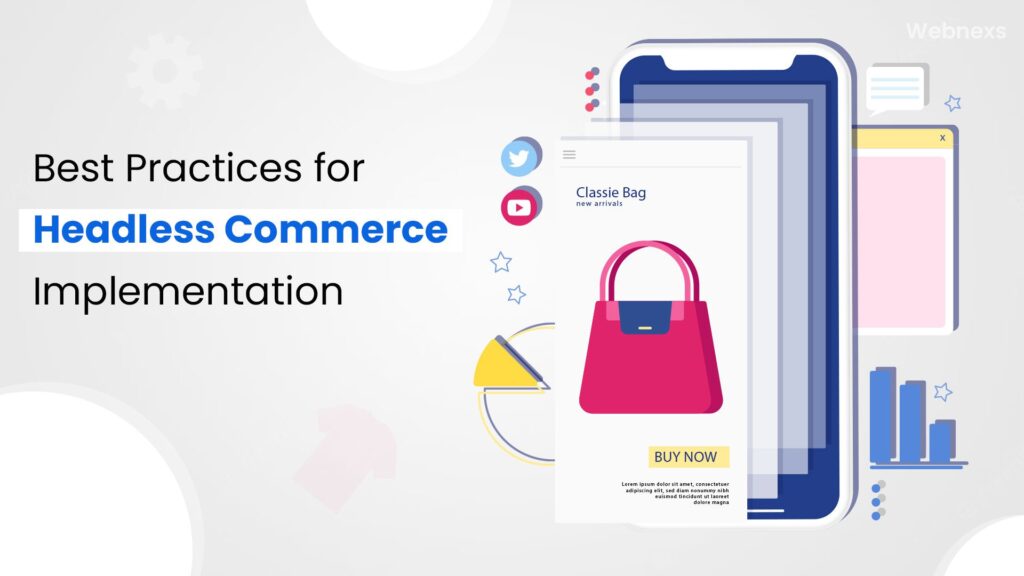
Implementing a headless commerce definition requires careful planning and execution. Here are some best practices
- Identify your business needs and goals
Before you start, it’s important to identify your business needs and goals. What are your key business objectives? What challenges are you trying to overcome? Understanding your business requirements will help ensure you choose the right platform that leads to your business goals.
- Choose the right headless commerce platform
There are a wide variety of headless commerce platforms available, and choosing the right one can be challenging. Consider factors such as ease of integration, scalability, security, and support when evaluating different platforms. Make sure the platform you choose can meet your specific business needs and requirements.
- Hire experienced developers
It requires a high level of technical expertise, so it’s important to hire experienced developers who have a deep understanding of APIs, microservices, and other related technologies. Look for developers who have experience working with the specific headless commerce platform you’ve chosen, as well as a track record of successful implementations.
- Plan for scalability and growth
Provides significant benefits in terms of scalability and flexibility, but it’s important to plan for growth from the outset. Make sure your implementation can handle increasing traffic and transaction volumes, and that you have a clear plan for scaling your infrastructure and resources as needed.
- Invest in ongoing training and support
It is a complex and rapidly evolving field, so it’s important to invest in ongoing training and support for your developers and other stakeholders. Headless commerce CMS can help your implementation stay up-to-date with the latest best practices and trends.
By following these best practices altogether, you can ensure a successful implementation that meets your business needs and provides a seamless omnichannel experience for your customers.
Final Words
In conclusion, headless commerce definition is a modern approach to e-commerce that separates the front-end and back-end functionalities of an online store.
By decoupling these two components, businesses achieve greater flexibility, scalability, and customization in their online shopping experiences. What is headless commerce? Headless ecommerce meaning and key features of headless commerce include API-driven architecture, omnichannel support, and ease of integration with third-party systems.
Transform your online business with Headless Ecommerce CMS Development. By this time say goodbye to the limitations of traditional ecommerce platforms and embrace the freedom of headless architecture.
Our expert team will build a custom Headless Commerce CMS solution that perfectly fits your business needs, giving you full control over the user experience and allowing you to easily integrate with any third-party systems.
Join the ranks of industry pioneers and revolutionize your ecommerce business with Headless Ecommerce CMS Development. Contact us today to discuss your requirements and start your journey toward a future-proof ecommerce solution!






58 Responses
The headless architecture accelerates time to market, enables e-commerce companies to differentiate and enhance the consumer experience, and offers virtually endless customization options.
The conversion rate, site speed, and time to market of e-commerce brands that use our platform to create headless storefronts are all on average 38 percent higher.
Because a commerce platform is flexible, your developers may create quickly with complete autonomy over all tools, code, APIs, and third-party integrations.
If you work in e-commerce, you are aware that it can be challenging (and frequently requires a lot of coffee) to keep up with new touchpoints and experiences. The best way to approach commerce is headlessly.
However, the definition of “headless commerce” could seem a little hazy because it necessitates a thorough comprehension of the advantages of dividing these two entities.
For companies that place a lot of emphasis on branding or content marketing, headless commerce might be a good option. Consequently, B2B-focused companies and companies that use unconventional design templates.
How do these two layers function together, though, if the frontend and backend are not linked?
In terms of software development, headless commerce architecture is a relatively recent idea. What are its working principles and advantages for an eCommerce company?
Short version: Headless commerce enables enterprises to create a platform that satisfies their existing business demands and exceeds customer expectations by offering a high level of technical flexibility.
A clear and precise explanation of why professional headless commerce should be considered. Thank you for sharing your experience.
The way you defined about explained headless commerce was simple and good. Thanks for sharing your thoughts
Wasn’t it your blog that taught me about the benefits of switching to headless commerce, which makes e-commerce sites more competitive?
A headless content management system (CMS) should be used if you want to deliver content to visitors through various channels, isn’t it?
Will we be able to unlock total creative control with headless commerce and Webnexs?
It’s great information for e-commerce owners and merchants. Keep sharing. Thanks
What a great piece of article!
Recently I read your post, and I just fell in love with your writing on headless.?
The cost of going headless ultimately depends on the complexity of your build. So how much does it cost to construct something without a head?
A Google study found that consumers are more likely to spend 40% more than planned when the experience is highly personalized, and endless merchandising is key to personalization.
This is an amazing blog! Excellent work on headless e-commerce has arisen as a methodology that uses the headless or decoupled CMS’s omnichannel abilities.
This is fascinating information on headless commerce and its features!
What amazing Information! Before starting an eCommerce business, you must be aware of list of features in headless.
Nice Blog! the features you integrate to enhance the expertise of your eCommerce customers.
What a fantastic piece of writing! The success of an eCommerce application depends largely on the platform you choose.
This is amazing to know Content Management System Pairing are the great deal with headless?
Before the advent of headless commerce origin, how did things function?
Furthermore, front-end developers concentrate on how the material should be shown in any framework, technically, right?
Should you choose headless ecommerce over all other options?
The flexibility of the headless is the only thing that put it in the first position and makes it even more speed and full autonomy of tools, not limiting it, still a lot more I heard about the headless.
Everyone is aware that internet usage has changed significantly over the past ten or even two years. We appreciate you bringing this up.
I appreciate you writing this on the headless commerce definition because it is particularly relevant today. In the midst of a global supply chain crisis and rising inflation, businesses are being told to do more with less.
Businesses that heavily invest in content marketing or branding, companies that use non-traditional design templates, and companies that rely on B2B operations may find that headless commerce is a good solution.
A study shows that more than 74% of online shoppers look to buy online via an Amazon-like ecommerce store – what does it mean? Headless is here to stay!
Without a connected front-end, the content is delivered by API calls, that good to have in ecommerce site which makes it even more flexible from all side.
Before diving into the benefits of headless eCommerce, first, let me know what headless eCommerce is and how I can deploy it for my site.
What happened before headless e-commerce platforms?
With traditional e-commerce, you work with a front-end template (your website) that connects to the backend e-commerce functionality. Whereas headless technology left all those headaches, We hope that’s why developers love having headless commerce sites. Thanks for a nice blog on the whole.
But for a headless e-commerce site, your front-end content is not connected to the backend, so which gives a more personalised site experience? I would like you to build one for me; please respond.
Why are people switching to headless CMS when the buying journey is now defined by the customer? Why does it make sense to handcuff the front and back end in this day and age?
For example, a simple headless setup can use WordPress as the CMS for content management?
Headless e-commerce is the separation of an e-commerce website’s frontend and backend. Isn’t this a great feature in and of itself?
Large organizations use headless e-commerce because it gives them the opportunity to scale without integrating additional solutions; that’s amazing to know.
Brands can now experiment with more creative content on their websites thanks to their improved ability to control all the elements that users interact with. there won’t be any other good definition for headless commerce.
Headless commerce is hot and happening. But even so, it might be a bit confusing, can you explain?
With headless e-commerce, you will need to build the front end from scratch, but one of my clients, who is a past client of Webnexs, told me they made it really easy and never crossed the timeline. Give it a try with Webnexs headless solution.
Many eCommerce businesses, from big brands to small businesses, have begun to move and adopt headless solutions; keep us updated on what you’re doing now.
In headless computing, the customer interface is ideally separated, and there are numerous opportunities for improvement on either end. If you would like to learn more about this, please leave your contact information.
What Are The Advantages Of Knowing Headless Commerce Definition?
Is Headless only for online stores? No idea, I just and hope to build?
Meanwhile, creative teams focus on what they do best, what your team from webnexs do, awaiting to know about it please, thanks.
With no doubt, headless ecommerce brings a lot more benefits to the users’ and developers’ tables.
While API calls and headless activations can make your cross-channel initiatives easier to implement and easier to implement, you must first ensure that your box is modular, headless, and relatively technology agnostic.
Fortunately, the fundamentals are simple to grasp. Are you in a hurry to get to the most important FAQs?
I appreciated the breakdown of the key features of headless commerce, especially the flexibility and scalability it offers. I can see how this would be particularly useful for businesses that need to adapt to changing customer demands and technologies.
This article does a great job of explaining the headless commerce definition in an easy-to-understand way. It’s refreshing to read an article on ecommerce that doesn’t require a degree in computer science to comprehend. Finally, I’ve found something that helped me. Thanks!
Very good article to know what headless commerce is exactly means. I’m experiencing a few of these issues as well.
However, there is still a lot of confusion surrounding headless-related issues, which has grown recently with the rise of trends such as headless commerce, API-first, and so on.
I hope now developers have complete control over the development process as they are now available with whole new tools, APIs and all others. Where it all he’s is in the integration part, right?